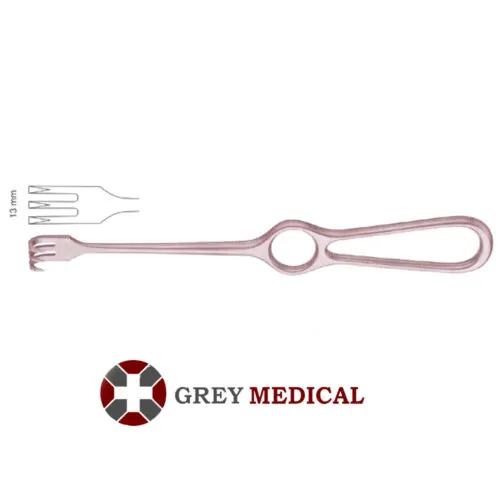Kocher Rake Retractor
Kocher Retractor, 22cm Kocher Rake Retractor is a surgical tool that allows surgeons to pull back the skin, tendons, and other soft tissues during surgeries involving the distal part of the limbs.

In any surgical setting, having the right instruments can make all the difference in patient outcomes. The Kocher surgical tool, with its unique features and versatile applications, is a must-have in every surgical toolkit. This blog will guide healthcare professionals on choosing the right Kocher surgical tool for their practice.
Understanding Different Types of Kocher Forceps
While the Kocher forceps have a standard design, they come in various types to cater to specific surgical needs:
-
Straight Kocher Forceps: These are the traditional design, suitable for general tissue handling. They provide excellent grip and control for most surgical procedures.
-
Curved Kocher Forceps: Curved versions offer enhanced access to difficult-to-reach areas, making them ideal for complex surgeries, especially in the abdomen and pelvis.
-
Mini Kocher Forceps: Smaller versions are designed for pediatric surgeries or delicate procedures where precision is crucial. Their compact size allows for better maneuverability in tight spaces.
Factors to Consider When Selecting Kocher Forceps
-
Size: Consider the specific procedures you will be performing. The size of the Kocher forceps should match the surgical site to ensure effective tissue handling.
-
Material Quality: High-quality stainless steel is the preferred material for Kocher forceps, as it offers durability and resistance to corrosion. Ensure that the instrument is made from medical-grade materials to maintain sterility and longevity.
-
Locking Mechanism: Evaluate the locking mechanism of the Kocher forceps. A smooth and reliable locking mechanism allows for effortless engagement and disengagement during procedures.
-
Ergonomics: Look for Kocher forceps with ergonomic handles that provide a comfortable grip. This is especially important for lengthy procedures, as it reduces hand fatigue and improves precision.
Maintenance and Care of Kocher Surgical Tools
To ensure the longevity and effectiveness of Kocher forceps, proper maintenance is essential:
-
Regular Cleaning: Following each use, clean Kocher forceps thoroughly to remove blood, tissue, and other contaminants. This prevents corrosion and maintains instrument integrity.
-
Sterilization: Autoclaving or using chemical sterilization methods is crucial to ensure that the Kocher forceps are free from pathogens before surgery.
-
Inspection: Regularly inspect the forceps for any signs of wear or damage. Look for any bending, rusting, or defects that may affect their performance.
-
Storage: Store Kocher forceps in a clean, dry place to prevent contamination. Use instrument trays or cases to protect them from damage.
Conclusion
Choosing the right Kocher surgical tool is crucial for healthcare professionals looking to enhance their surgical practices. By understanding the different types, considering key factors during selection, and adhering to proper maintenance protocols, surgeons can ensure that they have the best tools at their disposal. The Kocher surgical tool’s unique features and versatility make it an essential instrument for achieving successful surgical outcomes, benefiting both patients and practitioners alike.
What's Your Reaction?















